

Article Written by Jeffrey Stanton - 10/13/2011
William J. Warner, Jr. saw the potential of building an amusement park closer to Manhattan along Jamaica Bay in Canarsie. With the rapidly increasing population of New York’s five boroughs, and the spread of transit facilities, it made building an amusement park to compete with Coney Island profitable. The Jamaica Bay area, which included East New York and Brownsville had increased in population by 60,000 in the last three years. And with the extension of the elevated railroad system to Canarsie Landing, and trolley routes nearby, it was a shorter trip for potential patrons than to travel all the way to Coney Island.

Golden City, built by Warner’s Carnarsie Amusement Company, was built in 1907 on a 9-1/2 acre plot along Jamaica Bay adjacent to Canarise Landing on the southwest. They leased the land for 20 years from the Brooklyn and Canarsie Realty Company. The park owners also had an option on 25 acres of reclaimed land adjacent to the park for expansion.
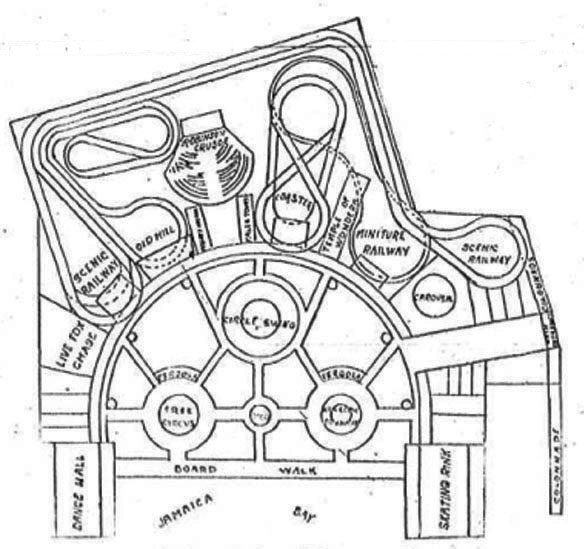
Layout of Golden City - 1907
Along the front of the park facing the bay, was a promenade 25 feet wide and 300 feet long. The buildings constructed of staff and corrugated iron, were built in Grecian architectural style and brilliantly illuminated by 145,000 lights at night. On Two short piers on either side of the park were large buildings 80 x 150 feet for dancing and roller skating. The entrance, which faced the promenade, was a 100 ft long arch with a sculpture of the Ben Hur chariot race atop the arch. The park’s costliest building was the Golden City Theater with a seating capacity of 2500 people. The building had two massive 140 foot high towers studded with 7000 electric bulbs. It would house, upon opening, an English scenic production of Robinson Crusoe.
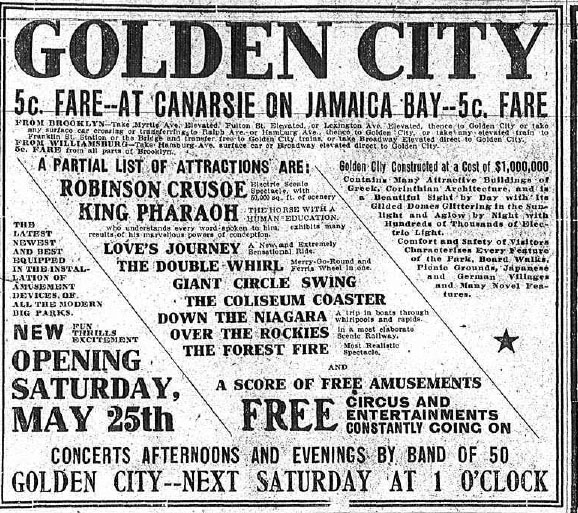
Opening Day Newspaper Ad - 1907
Golden City was scheduled to open on May 25, 1907, but the park wasn’t ready in time. And even when it did open on May 30th, Decoration Day, carpenters and painters were still working on several unfinished attractions. Still 25,000 curious people attended the grand opening.
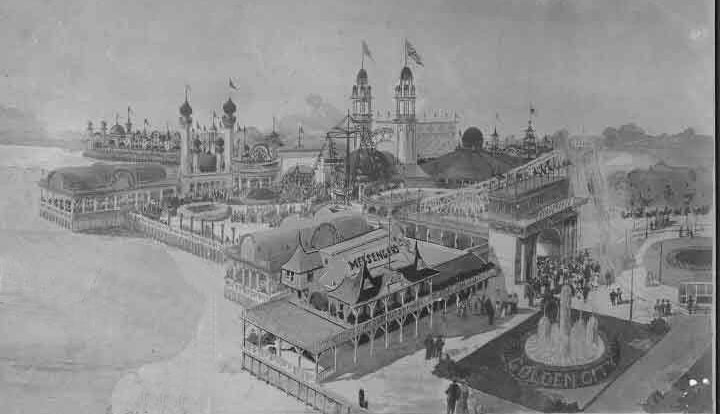
Aerial perspective drawing of Golen City Park - 1908
The park featured a number of rides, shows, and a free circus. There was Over the Rockies, an elaborate 4,200 foot-long scenic railway; The Forest Fire, a realistic spectacle of fire fighters taming a fire in a forest; Down the Niagara, a trip in boats through whirlpools and rapids with scenes of the Falls along the walls, the Coliseum Roller Coaster; a Murphy’s carved carousel; a Traver Giant Circle Swing; the Flying Lady illusion show; the Double Whirl, a small Ferris Wheel whose base revolved; Love’s Journey, where couples were whirled around in carousel style but also treated to the pleasures of dark passages and showers of confetti; and a miniature steam railroad. There were two fun house type rides; the Temple of Wonders and the Human Laundry. The later was a novel attraction where patrons were washed in a giant tub, then spun dry, thoroughly dried by wind, pressed between upright rollers, and sent down a laundry chute slide to the street. There was also a naphtha powered passenger boat seating 60, that took passengers for a tour of Jamaica Bay. Besides the free circus that featured trapeze and other acts, Conterno’s band occupied the band stand in the center of the park.
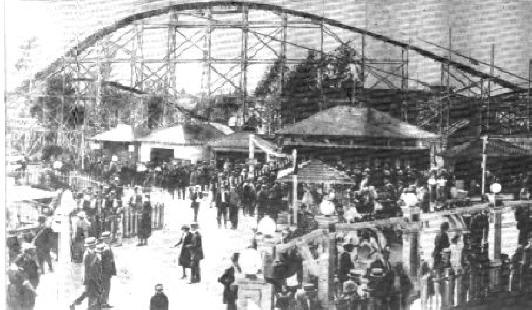
Coliseum roller coaster
The Robinson Crusoe show in the theater was the park’s most popular attraction. The electro-scenic production from England cost $60,000 to stage . It illustrated the popular juvenile adventure novel with 60,000 square feet of scenery moved by 14 giant motors in the 22 minute presentation. It showed the shipwreck, his life on the island with his man Friday, and their eventual rescue.
King Pharoah, an educated horse was a star attraction and drew huge crowds to its show. He was advertised as not a “trick” horse, but showed “the intelligence of a human being.’ Among the horse’s many stunts was reading, calculating with figures, spelling, distinguishing between colors, and picking the correct coin denomination from a pile of silver coins. He could spell his own name and short names of those in the audience. Amazingly, the horse could perform just as well when his trainer was absent , as when he was present.
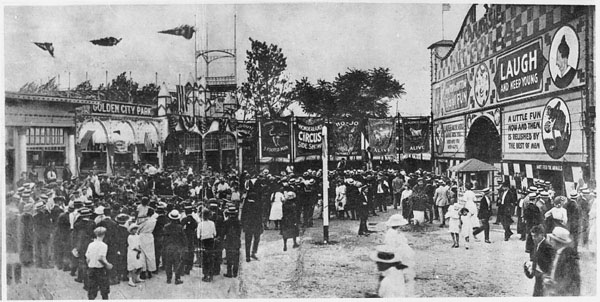
View inside Golden City Park
William Warner, Jr. president of Golden City was pleased with the park’s success and announced in August that it would be expanded to 50 acres on adjacent land over the following seasons. They also instituted a one price admission that included 25 of the park’s 10 cent attraction – all for 25 cents.
Hundreds of workmen were busy on Saturday May 8, 1909 with the finishing touches for Golden City’s season opening the following day, when a fire started in a restaurant, presumably from spilled grease on the range. The fire was discovered by Max A. Tiltz, manager of the restaurant, who rushed out into the street and yelled “Fire!” Several fishermen rushed over and tried to extinguish the fire while others ran to send in the fire alarm.
William Warner, Jr., President of the Canarsie Amusement Company, which owned the park, was making up the weekly payroll in his office next door to the restaurant, when he heard the cry of fire. He barely had time to quickly gather up several thousand dollars and escape.
The nearest fire house was in Canarsie City, a mile away. Engine Company 157 was making good time along Rockaway Avenue when one of the horses tripped on the railroad tracks and fell. The engine continued, but the tender carrying the hoses was delayed for 20 minutes. This gave the fire a good start, and by the time the tender arrived and the hose was stretched, the south side of the park was a mass of flames. Battalion Chief John J. Douglas sent in a second and third alarm. This brought additional fire companies from Brownsville, Flatbush and East New York.
Fireman cut a path to the center of the park and fought the flames so that it couldn’t go any further inland. This saved most of the park, but flames spread to Sunset Hotel on the waterfront and another owned by Lawrence Nessanger. Bystanders claimed that the firemen might have saved the hotels if the park’s entrance hadn’t toppled over upon the hose they were using.
Despite uninsured damages of $200,000 and the loss of the restaurant, dance hall, office and photo gallery, the park opened as scheduled. They transformed the skating rink into a dance hall. And since only part of the roller coaster was burned, it was repaired within a week.
Golden City Park also had novel new free attractions during the 1909 season. Arthur Holden , who was paid $700 / week for two performances daily, dove backward from a height of 110 feet into a tank of water only four feet deep. And the Death Trap Loop where Mme. Farino rode a bicycle down a ramp and through an overhead loop, was also paid $100 / day to perform the feat. The element of danger was increased by a self-working trap, a net-like device, that transferred the cyclist to the ground.
New shows included La Domino Rouge where 10 girls in ballet costumes performed the dance (can-can?) with electric lights and mirrors contributing to the illusion. Colored players as actors and actresses performed the Black Merry Window. The Auto Bee, an illusion show, had a girl riding in an automobile sail off the stage over the heads of the audience.
During the teens and twenties new rides were added to the park. Nunley’s Carousel, built by Brooklyn carvers Stein and Goldstein was added in 1912. It had 41 horses and one lion, and an organ that played carousel music. After the park closed it was moved to an amusement park in Baldwin, Long Island in 1939. A Whip ride was added in 1914. An old Mill boat ride (likely a remodel), had dark tunnels where spooks and devils almost scared passengers out of their wits.
Games in the park included Kill the Kats where people threw baseballs, three for a nickel, at cat targets. They would win a prize if they knocked over enough cats. There was a game where customers attempted to toss a ring over Dancing Dolls to win a prize.
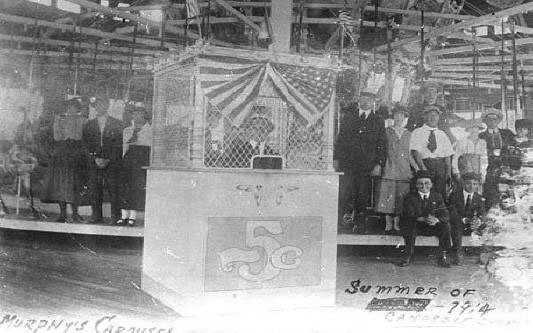
Nunley's Carousel - 1914
Beyond the park’s gates, just outside, was a boxing arena that staged famous fights both amateur and professional, and the Husman Music Hall that featured vaudeville shows. There were also many beer halls that gave the Canarsie area a rowdy reputation. But perhaps the town’s worst problem was an inadequate sewage system that dumped raw sewage into Jamaica Bay. The local fishing industry was decimated after all the fish in the Bay slowly died.
There was a fire at the park in 1934. It began in a row of nearby houses and quickly spread towards the amusement park. However it burned only several structures near the entrance before it was contained.
Golden City Park - 1930 MAP
By the early 1930’s Golden City Park was losing money. Milton Sheen was a lawyer for the owners, when they walked away from their money-losing business in 1934. Despite having never run an amusement business, Sheen thought that he might make it a success. Within a few years the park was out of the red. One of the thrilling attractions was Al Camin and his Wall of Death Ride where motorcycles roared around the nearly vertical walls of the track.
But Park’s Commissioner Robert Moses, the nemesis of all New York’s amusement park, and a man with the power to condemn neighborhoods for the building of highways, condemned Golden City in 1939. The park was razed and the Belt Parkway ran through the site along the edge of Jamaica Bay. The New York City Board of Estimate had money to rebuild the amusement park further inland, but the Canarsie’s Civic Association resisted. With the Backing of Robert Moses, they filed an injunction.